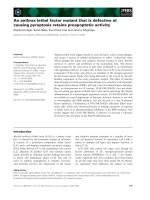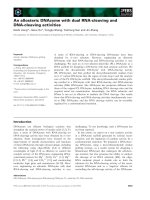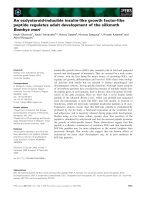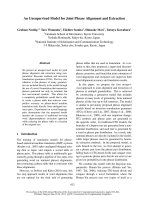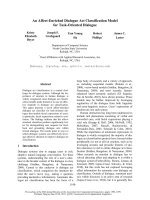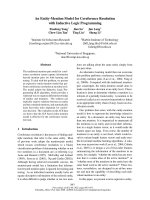Báo cáo khoa học: "An Ensemble Model that Combines Syntactic and Semantic Clustering for Discriminative Dependency Parsing" pptx
Bạn đang xem bản rút gọn của tài liệu. Xem và tải ngay bản đầy đủ của tài liệu tại đây (215.8 KB, 5 trang )
Proceedings of the 49th Annual Meeting of the Association for Computational Linguistics:shortpapers, pages 710–714,
Portland, Oregon, June 19-24, 2011.
c
2011 Association for Computational Linguistics
An Ensemble Model that Combines Syntactic and Semantic Clustering
for Discriminative Dependency Parsing
Gholamreza Haffari
Faculty of Information Technology
Monash University
Melbourne, Australia
Marzieh Razavi and Anoop Sarkar
School of Computing Science
Simon Fraser University
Vancouver, Canada
{mrazavi,anoop}@cs.sfu.ca
Abstract
We combine multiple word representations
based on semantic clusters extracted from the
(Brown et al., 1992) algorithm and syntac-
tic clusters obtained from the Berkeley parser
(Petrov et al., 2006) in order to improve dis-
criminative dependency parsing in the MST-
Parser framework (McDonald et al., 2005).
We also provide an ensemble method for com-
bining diverse cluster-based models. The two
contributions together significantly improves
unlabeled dependency accuracy from 90.82%
to 92.13%.
1 Introduction
A simple method for using unlabeled data in
discriminative dependency parsing was provided
in (Koo et al., 2008) which involved clustering the
labeled and unlabeled data and then each word in the
dependency treebank was assigned a cluster identi-
fier. These identifiers were used to augment the fea-
ture representation of the edge-factored or second-
order features, and this extended feature set was
used to discriminatively train a dependency parser.
The use of clusters leads to the question of
how to integrate various types of clusters (possibly
from different clustering algorithms) in discrimina-
tive dependency parsing. Clusters obtained from the
(Brown et al., 1992) clustering algorithm are typi-
cally viewed as “semantic”, e.g. one cluster might
contain plan, letter, request, memo, . . . while an-
other may contain people, customers, employees,
students, . . Another clustering view that is more
“syntactic” in nature comes from the use of state-
splitting in PCFGs. For instance, we could ex-
tract a syntactic cluster loss, time, profit, earnings,
performance, rating, . . .: all head words of noun
phrases corresponding to cluster of direct objects of
verbs like improve. In this paper, we obtain syn-
tactic clusters from the Berkeley parser (Petrov et
al., 2006). This paper makes two contributions: 1)
We combine together multiple word representations
based on semantic and syntactic clusters in order to
improve discriminative dependency parsing in the
MSTParser framework (McDonald et al., 2005), and
2) We provide an ensemble method for combining
diverse clustering algorithms that is the discrimina-
tive parsing analog to the generative product of ex-
perts model for parsing described in (Petrov, 2010).
These two contributions combined significantly im-
proves unlabeled dependency accuracy: 90.82% to
92.13% on Sec. 23 of the Penn Treebank, and we
see consistent improvements across all our test sets.
2 Dependency Parsing
A dependency tree represents the syntactic structure
of a sentence with a directed graph (Figure 1), where
nodes correspond to the words, and arcs indicate
head-modifier pairs (Mel’
ˇ
cuk, 1987). Graph-based
dependency parsing searches for the highest-scoring
tree according to a part-factored scoring function. In
the first-order parsing models, the parts are individ-
ual head-modifier arcs in the dependency tree (Mc-
Donald et al., 2005). In the higher-order models, the
parts consist of arcs together with some context, e.g.
the parent or the sister arcs (McDonald and Pereira,
2006; Carreras, 2007; Koo and Collins, 2010). With
a linear scoring function, the parse for a sentence s
is:
PARSE(s) = arg max
t∈T (s)
r∈t
w · f (s, r) (1)
where T (s) is the space of dependency trees for s,
and f (s, r) is the feature vector for the part r which
is linearly combined using the model parameter w
to give the part score. The above arg max search
for non-projective dependency parsing is accom-
710
root
For
IN-1
PP-2
0111
Japan
NNP-19
NP-10
0110
,
,-0
,-0
0010
the
DT-15
DT-15
1101
trend
NN-23
NP-18
1010
improves
VBZ-1
S-14
0101
access
NN-13
NP-24
0011
to
TO-0
TO-0
0011
American
JJ-31
JJ-31
0110
markets
NNS-25
NP-9
1011
Figure 1: Dependency tree with cluster identifiers obtained from the split non-terminals from the Berkeley parser output. The first
row under the words are the split POS tags (Syn-Low), the second row are the split bracketing tags (Syn-High), and the third row is
the first 4 bits (to save space in this figure) of the (Brown et al., 1992) clusters.
plished using minimum spanning tree algorithms
(West, 2001) or approximate inference algorithms
(Smith and Eisner, 2008; Koo et al., 2010). The
(Eisner, 1996) algorithm is typically used for pro-
jective parsing. The model parameters are trained
using a discriminative learning algorithm, e.g. av-
eraged perceptron (Collins, 2002) or MIRA (Cram-
mer and Singer, 2003). In this paper, we work with
both first-order and second-order models, we train
the models using MIRA, and we use the (Eisner,
1996) algorithm for inference.
The baseline features capture information about
the lexical items and their part of speech (POS) tags
(as defined in (McDonald et al., 2005)). In this work,
following (Koo et al., 2008), we use word cluster
identifiers as the source of an additional set of fea-
tures. The reader is directed to (Koo et al., 2008)
for the list of cluster-based feature templates. The
clusters inject long distance syntactic or semantic in-
formation into the model (in contrast with the use
of POS tags in the baseline) and help alleviate the
sparse data problem for complex features that in-
clude n-grams.
3 The Ensemble Model
A word can have different syntactic or semantic
cluster representations, each of which may lead to a
different parsing model. We use ensemble learning
(Dietterich, 2002) in order to combine a collection
of diverse and accurate models into a more powerful
model. In this paper, we construct the base models
based on different syntactic/semantic clusters used
in the features in each model. Our ensemble parsing
model is a linear combination of the base models:
PARSE(s) = arg max
t∈T (s)
k
α
k
r∈t
w
k
· f
k
(s, r) (2)
where α
k
is the weight of the kth base model, and
each base model has its own feature mapping f
k
(.)
based on its cluster annotation. Each expert pars-
ing model in the ensemble contains all of the base-
line and the cluster-based feature templates; there-
fore, the experts have in common (at least) the base-
line features. The only difference between individ-
ual parsing models is the assigned cluster labels, and
hence some of the cluster-based features. In a fu-
ture work, we plan to take the union of all of the
feature sets and train a joint discriminative parsing
model. The ensemble approach seems more scal-
able though, since we can incrementally add a large
number of clustering algorithms into the ensemble.
4 Syntactic and Semantic Clustering
In our ensemble model we use three different clus-
tering methods to obtain three types of word rep-
resentations that can help alleviate sparse data in a
dependency parser. Our first word representation is
exactly the same as the one used in (Koo et al., 2008)
where words are clustered using the Brown algo-
rithm (Brown et al., 1992). Our two other clusterings
are extracted from the split non-terminals obtained
from the PCFG-based Berkeley parser (Petrov et al.,
2006). Split non-terminals from the Berkeley parser
output are converted into cluster identifiers in two
different ways: 1) the split POS tags for each word
are used as an alternate word representation. We
call this representation Syn-Low, and 2) head per-
colation rules are used to label each non-terminal in
the parse such that each non-terminal has a unique
daughter labeled as head. Each word is assigned a
cluster identifier which is defined as the parent split
non-terminal of that word if it is not marked as head,
else if the parent is marked as head we recursively
check its parent until we reach the unique split non-
terminal that is not marked as head. This recursion
terminates at the start symbol TOP. We call this rep-
resentation Syn-High. We only use cluster identi-
fiers from the Berkeley parser, rather than dependen-
cies, or any other information.
711
First order features
Sec Baseline BrownSyn-LowSyn-High Ensemble
00 89.61 90.39 90.01 89.97 90.82
34.68 36.97 34.42 34.94 37.96
01 90.44 91.48 90.89 90.76 91.84
36.36 38.62 35.66 36.56 39.67
23 90.02 91.13 90.46 90.35 91.30
34.13 39.64 36.95 35.00 39.43
24 88.84 90.06 89.44 89.40 90.33
30.85 34.49 32.49 31.22 34.05
Second order features
Sec Baseline BrownSyn-LowSyn-High Ensemble
00 90.34 90.98 90.89 90.59 91.41
38.02 41.04 38.80 39.16 40.93
01 91.48 92.13 91.95 91.72 92.51
41.48 43.84 42.24 41.28 45.05
23 90.82 91.84 91.31 91.21 92.13
39.18 43.66 40.84 39.97 44.28
24 89.87 90.61 90.28 90.31 91.18
35.53 37.99 37.32 35.61 39.55
Table 1: For each test section and model, the number in the
first/second row is the unlabeled-accuracy/unlabeled-complete-
correct. See the text for more explanation.
(TOP
(S-14
(PP-2 (IN-1 For)
(NP-10 (NNP-19 Japan)))
(,-0 ,)
(NP-18 (DT-15 the) (NN-23 trend))
(VP-6 (VBZ-1 improves)
(NP-24 (NN-13 access))
(PP-14 (TO-0 to)
(NP-9 (JJ-31 American)
(NNS-25 markets))))))
For the Berkeley parser output shown above, the
resulting word representations and dependency tree
is shown in Fig. 1. If we group all the head-words in
the training data that project up to split non-terminal
NP-24 then we get a cluster: loss, time, profit, earn-
ings, performance, rating, . . . which are head words
of the noun phrases that appear as direct object of
verbs like improve.
5 Experimental Results
The experiments were done on the English Penn
Treebank, using standard head-percolation rules
(Yamada and Matsumoto, 2003) to convert the
phrase structure into dependency trees. We split the
Treebank into a training set (Sections 2-21), a devel-
Verb Noun Pronoun Adverb Adjective Adpos. Conjunc.
0.04 0.06 0.08 0.10 0.12 0.14
Baseline
Brown
Syn−Low
Syn−High
Ensemble
(a)
1 3 5 7 9 11 13 +15
0.80 0.85 0.90 0.95
Dependency length
Fscore
!
!
!
!
!
!
!
!
!
!
!
!
!
!
!
!
!
!
!
!
!
!
!
!
!
!
!
!
!
!
!
!
!
!
!
!
!
!
!
!
!
!
!
!
!
!
!
!
Baseline
Brown
Syn−Low
Syn−High
Ensemble
(b)
Figure 2: (a) Error rate of the head attachment for different
types of modifier categories. (b) F-score for each dependency
length.
opment set (Section 22), and test sets (Sections 0,
1, 23, and 24). All our experimental settings match
previous work (Yamada and Matsumoto, 2003; Mc-
Donald et al., 2005; Koo et al., 2008). POS tags for
the development and test data were assigned by MX-
POST (Ratnaparkhi, 1996), where the tagger was
trained on the entire training corpus. To generate
part of speech tags for the training data, we used 20-
way jackknifing, i.e. we tagged each fold with the
tagger trained on the other 19 folds. We set model
weights α
k
in Eqn (2) to one for all experiments.
Syntactic State-Splitting The sentence-specific
word clusters are derived from the parse trees using
712
Berkeley parser
1
, which generates phrase-structure
parse trees with split syntactic categories. To gen-
erate parse trees for development and test data, the
parser is trained on the entire training data to learn
a PCFG with latent annotations using split-merge
operations for 5 iterations. To generate parse trees
for the training data, we used 20-way jackknifing as
with the tagger.
Word Clusterings from Brown Algorithm The
word clusters were derived using Percy Liang’s im-
plementation of the (Brown et al., 1992) algorithm
on the BLLIP corpus (Charniak et al., 2000) which
contains ∼43M words of Wall Street Journal text.
2
This produces a hierarchical clustering over the
words which is then sliced at a certain height to ob-
tain the clusters. In our experiments we use the clus-
ters obtained in (Koo et al., 2008)
3
, but were unable
to match the accuracy reported there, perhaps due to
additional features used in their implementation not
described in the paper.
4
Results Table 1 presents our results for each
model on each test set. In this table, the baseline
(first column) does not use any cluster-based fea-
tures, the next three models use cluster-based fea-
tures using different clustering algorithms, and the
last column is our ensemble model which is the lin-
ear combination of the three cluster-based models.
As Table 1 shows, the ensemble model has out-
performed the baseline and individual models in al-
most all cases. Among the individual models, the
model with Brown semantic clusters clearly outper-
forms the baseline, but the two models with syntac-
tic clusters perform almost the same as the baseline.
The ensemble model outperforms all of the individ-
ual models and does so very consistently across both
first-order and second-order dependency models.
Error Analysis To better understand the contri-
bution of each model to the ensemble, we take a
closer look at the parsing errors for each model and
the ensemble. For each dependent to head depen-
1
code.google.com/p/berkeleyparser
2
Sentences of the Penn Treebank were excluded from the
text used for the clustering.
3
people.csail.mit.edu/maestro/papers/bllip-clusters.gz
4
Terry Koo was kind enough to share the source code for the
(Koo et al., 2008) paper with us, and we plan to incorporate all
the features in our future work.
dency, Fig. 2(a) shows the error rate for each depen-
dent grouped by a coarse POS tag (c.f. (McDonald
and Nivre, 2007)). For most POS categories, the
Brown cluster model is the best individual model,
but for Adjectives it is Syn-High, and for Pronouns
it is Syn-Low that is the best. But the ensemble al-
ways does the best in every grammatical category.
Fig. 2(b) shows the F-score of the different models
for various dependency lengths, where the length of
a dependency from word w
i
to word w
j
is equal to
|i − j|. We see that different models are experts on
different lengths (Syn-Low on 8, Syn-High on 9),
while the ensemble model can always combine their
expertise and do better at each length.
6 Comparison to Related Work
Several ensemble models have been proposed for
dependency parsing (Sagae and Lavie, 2006; Hall et
al., 2007; Nivre and McDonald, 2008; Attardi and
Dell’Orletta, 2009; Surdeanu and Manning, 2010).
Essentially, all of these approaches combine dif-
ferent dependency parsing systems, i.e. transition-
based and graph-based. Although graph-based mod-
els are globally trained and can use exact inference
algorithms, their features are defined over a lim-
ited history of parsing decisions. Since transition-
based parsing models have the opposite character-
istics, the idea is to combine these two types of
models to exploit their complementary strengths.
The base parsing models are either independently
trained (Sagae and Lavie, 2006; Hall et al., 2007;
Attardi and Dell’Orletta, 2009; Surdeanu and Man-
ning, 2010), or their training is integrated, e.g. using
stacking (Nivre and McDonald, 2008; Attardi and
Dell’Orletta, 2009; Surdeanu and Manning, 2010).
Our work is distinguished from the aforemen-
tioned works in two dimensions. Firstly, we com-
bine various graph-based models, constructed using
different syntactic/semantic clusters. Secondly, we
do exact inference on the shared hypothesis space of
the base models. This is in contrast to previous work
which combine the best parse trees suggested by the
individual base-models to generate a final parse tree,
i.e. a two-phase inference scheme.
7 Conclusion
We presented an ensemble of different dependency
parsing models, each model corresponding to a dif-
713
ferent syntactic/semantic word clustering annota-
tion. The ensemble obtains consistent improve-
ments in unlabeled dependency parsing, e.g. from
90.82% to 92.13% for Sec. 23 of the Penn Tree-
bank. Our error analysis has revealed that each syn-
tactic/semantic parsing model is an expert in cap-
turing different dependency lengths, and the ensem-
ble model can always combine their expertise and
do better at each dependency length. We can in-
crementally add a large number models using dif-
ferent clustering algorithms, and our preliminary re-
sults show increased improvement in accuracy when
more models are added into the ensemble.
Acknowledgements
This research was partially supported by NSERC,
Canada (RGPIN: 264905). We would like to thank
Terry Koo for his help with the cluster-based fea-
tures for dependency parsing and Ryan McDonald
for the MSTParser source code which we modified
and used for the experiments in this paper.
References
G. Attardi and F. Dell’Orletta. 2009. Reverse revision
and linear tree combination for dependency parsing.
In Proc. of NAACL-HLT.
P. F. Brown, P. V. deSouza, R. L. Mercer, T. J. Watson,
V. J. Della Pietra, and J. C. Lai. 1992. Class-based
n-gram models of natural language. Computational
Linguistics, 18(4).
X. Carreras. 2007. Experiments with a higher-order pro-
jective dependency parser. In Proc. of EMNLP-CoNLL
Shared Task.
E. Charniak, D. Blaheta, N. Ge, K. Hall, and M. Johnson.
2000. BLLIP 1987-89 WSJ Corpus Release 1, LDC
No. LDC2000T43, Linguistic Data Consortium.
M. Collins. 2002. Discriminative training methods for
hidden markov models: theory and experiments with
perceptron algorithms. In Proc. of EMNLP.
K. Crammer and Y. Singer. 2003. Ultraconservative
online algorithms for multiclass problems. J. Mach.
Learn. Res., 3:951–991.
T. Dietterich. 2002. Ensemble learning. In The Hand-
book of Brain Theory and Neural Networks, Second
Edition.
J. Eisner. 1996. Three new probabilistic models for de-
pendency parsing: an exploration. In COLING.
J. Hall, J. Nilsson, J. Nivre, G. Eryigit, B. Megyesi,
M. Nilsson, and M. Saers. 2007. Single malt or
blended? a study in multilingual parser optimization.
In Proc. of CoNLL Shared Task.
T. Koo and M. Collins. 2010. Efficient third-order de-
pendency parsers. In Proc. of ACL.
T. Koo, X. Carreras, and M. Collins. 2008. Simple semi-
supervised dependency parsing. In Proc. of ACL/HLT.
T. Koo, A. Rush, M. Collins, T. Jaakkola, and D. Son-
tag. 2010. Dual decomposition for parsing with non-
projective head automata. In Proc. of EMNLP.
R. McDonald and J. Nivre. 2007. Characterizing the
errors of data-driven dependency parsing models. In
Proc. of EMNLP-CONLL.
R. McDonald and F. Pereira. 2006. Online learning of
approximate dependency parsing algorithms. In Proc.
of EACL.
R. McDonald, K. Crammer, and F. Pereira. 2005. Online
large-margin training of dependency parsers. In Proc.
of ACL.
I. Mel’
ˇ
cuk. 1987. Dependency syntax: theory and prac-
tice. State University of New York Press.
J. Nivre and R. McDonald. 2008. Integrating graph-
based and transition-based dependency parsers. In
Proc. of ACL.
S. Petrov, L. Barrett, R. Thibaux, and D. Klein. 2006.
Learning accurate, compact, and interpretable tree an-
notation. In Proc. COLING-ACL.
S. Petrov. 2010. Products of random latent variable
grammars. In Proc. of NAACL-HLT.
A. Ratnaparkhi. 1996. A maximum entropy model for
part-of-speech tagging. In Proc. of EMNLP.
K. Sagae and A. Lavie. 2006. Parser combination by
reparsing. In Proc. of NAACL-HLT.
D. A. Smith and J. Eisner. 2008. Dependency parsing by
belief propagation. In Proc. of EMNLP.
M. Surdeanu and C. Manning. 2010. Ensemble models
for dependency parsing: Cheap and good? In Proc. of
NAACL.
D. West. 2001. Introduction to Graph Theory. Prentice
Hall, 2nd editoin.
H. Yamada and Y. Matsumoto. 2003. Statistical depen-
dency analysis with support vector machines. In Proc.
of IWPT.
714

